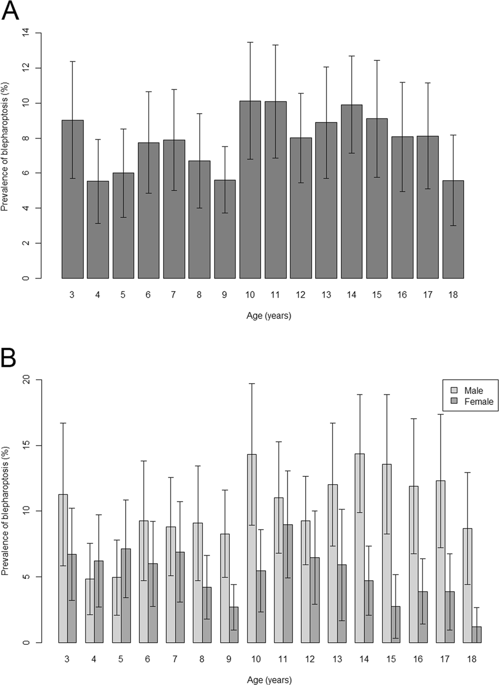Our official English website, www.x-mol.net, welcomes your
feedback! (Note: you will need to create a separate account there.)
Prevalence and risk factors of childhood blepharoptosis in Koreans: the Korea National Health and Nutrition Examination Survey
Eye ( IF 2.8 ) Pub Date : 2019-11-26 , DOI: 10.1038/s41433-019-0697-3 Bum-Joo Cho 1, 2 , Youn Joo Choi 3 , Min Chul Shin 4 , Suk-Woo Yang 5 , Min Joung Lee 1
Eye ( IF 2.8 ) Pub Date : 2019-11-26 , DOI: 10.1038/s41433-019-0697-3 Bum-Joo Cho 1, 2 , Youn Joo Choi 3 , Min Chul Shin 4 , Suk-Woo Yang 5 , Min Joung Lee 1
Affiliation

|
Childhood blepharoptosis may cause cosmetic and functional problems in children, but there is a paucity of studies about its epidemiology. This study aimed to investigate the prevalence of childhood blepharoptosis and associated risk factors in a representative Korean population. This cross-sectional nation-wide study analysed the data set acquired from the Korea National Health and Nutrition Examination Survey 2008–2012. A total of 8218 children aged 3–18 years were included. The prevalence of childhood blepharoptosis, defined as a margin reflex distance (MRD) of < 2 mm in either eye, was estimated, and the risk factors were identified using multivariate logistic regression analysis. The mean age of participants was 11.3 ± 0.1 years, and 52.8 ± 0.6% were boys. The overall prevalence of childhood blepharoptosis in Korea was 8.0% (95% CI, 6.9–9.1%). Boys exhibited a higher prevalence of blepharoptosis than girls at most of ages. Levator function increased with age in the normal general population. The proportion of subjects exhibiting MRD1 ≥ 4.0 mm also increased significantly with age (p < 0.001). Male gender, higher body mass index, and urban residency were significantly associated with childhood blepharoptosis. The prevalence of childhood blepharoptosis is higher in urban obese boys. The increase of levator function with age should be considered in evaluations of childhood ptosis.
中文翻译:

韩国人儿童上睑下垂的患病率和危险因素:韩国国家健康和营养检查调查
儿童上睑下垂可能会导致儿童的美容和功能问题,但关于其流行病学的研究很少。本研究旨在调查韩国代表性人群中儿童上睑下垂的患病率和相关危险因素。这项横断面全国性研究分析了从 2008-2012 年韩国国家健康和营养检查调查中获得的数据集。共纳入 8218 名 3-18 岁儿童。估计儿童上睑下垂的患病率,定义为每只眼睛的边缘反射距离 (MRD) < 2 mm,并使用多变量逻辑回归分析确定危险因素。参与者的平均年龄为 11.3 ± 0.1 岁,52.8 ± 0.6% 是男孩。韩国儿童上睑下垂的总体患病率为 8.0%(95% CI,6.9-9。1%)。在大多数年龄段,男孩的上睑下垂患病率高于女孩。在正常的一般人群中,提肌功能随着年龄的增长而增加。表现出 MRD1 ≥ 4.0 mm 的受试者比例也随着年龄的增长而显着增加(p < 0.001)。男性、较高的体重指数和城市居民与儿童上睑下垂显着相关。城市肥胖男孩儿童上睑下垂的患病率较高。在评估儿童上睑下垂时应考虑提肌功能随年龄增长的增加。和城市居民与儿童上睑下垂显着相关。城市肥胖男孩儿童上睑下垂的患病率较高。在评估儿童上睑下垂时应考虑提肌功能随年龄增长的增加。和城市居民与儿童上睑下垂显着相关。城市肥胖男孩儿童上睑下垂的患病率较高。在评估儿童上睑下垂时应考虑提肌功能随年龄增长的增加。
更新日期:2019-11-26
中文翻译:

韩国人儿童上睑下垂的患病率和危险因素:韩国国家健康和营养检查调查
儿童上睑下垂可能会导致儿童的美容和功能问题,但关于其流行病学的研究很少。本研究旨在调查韩国代表性人群中儿童上睑下垂的患病率和相关危险因素。这项横断面全国性研究分析了从 2008-2012 年韩国国家健康和营养检查调查中获得的数据集。共纳入 8218 名 3-18 岁儿童。估计儿童上睑下垂的患病率,定义为每只眼睛的边缘反射距离 (MRD) < 2 mm,并使用多变量逻辑回归分析确定危险因素。参与者的平均年龄为 11.3 ± 0.1 岁,52.8 ± 0.6% 是男孩。韩国儿童上睑下垂的总体患病率为 8.0%(95% CI,6.9-9。1%)。在大多数年龄段,男孩的上睑下垂患病率高于女孩。在正常的一般人群中,提肌功能随着年龄的增长而增加。表现出 MRD1 ≥ 4.0 mm 的受试者比例也随着年龄的增长而显着增加(p < 0.001)。男性、较高的体重指数和城市居民与儿童上睑下垂显着相关。城市肥胖男孩儿童上睑下垂的患病率较高。在评估儿童上睑下垂时应考虑提肌功能随年龄增长的增加。和城市居民与儿童上睑下垂显着相关。城市肥胖男孩儿童上睑下垂的患病率较高。在评估儿童上睑下垂时应考虑提肌功能随年龄增长的增加。和城市居民与儿童上睑下垂显着相关。城市肥胖男孩儿童上睑下垂的患病率较高。在评估儿童上睑下垂时应考虑提肌功能随年龄增长的增加。











































 京公网安备 11010802027423号
京公网安备 11010802027423号